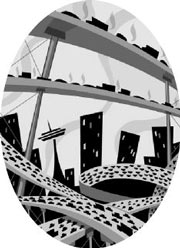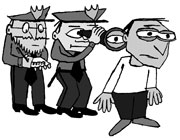THIS FALL, VOTERS will be asked, as periodically happens, to pony up yet another large sum of money to fix traffic problems, which never seem to get fixed.
Environmental groups are already lining up with concerns about Referendum 51, which goes heavy on the road building at a time when Tim Eyman’s free enterprise schemes have limited the available funds for public transit. As a card-carrying tree worshiper (forget hugging; I kneel and pray), I should be beyond skeptical. I should be exuding fire-breathing hostility. They’re paving over our planet, you know!
Pave s’more.
This bit of heresy is what is known as a reality check. Will new and expanded road building encourage more sprawl? Yep. Will it create construction inconvenience, even displace neighborhoods? Of course. Will the lanes fill up with more cars before the asphalt’s dry? You bet.
Do it.
Those very real concerns are far outweighed by two bits of reality many fellow enviros either don’t notice or would rather not acknowledge.
First, environmentalism should encompass protecting not just wild spaces, but the “ruined” urban spaces most of us live in. Sprawl isn’t just a future threat; it’s happened already, and its participants aren’t moving back where they came from. As more people come to our region—often attracted by our spectacular natural setting—they’re not all going to telecommute or move into densely packed Belltown condos, no matter what the transportation package looks like.
Seattle does not have the second-worst (or whatever) traffic in the country. Traffic follows metropolitan areas, not city limits, and Seattle is about the 12th-biggest city in the country. Not surprisingly, about that many cities, and all of the larger ones—think New York, L.A., Chicago, Houston, Atlanta, Miami, Boston, San Francisco—have traffic at least as bad as here. But only one U.S. city—New York—has a combination of density and geography that supports a transit system that allows people of any income to not own cars and not be considered freaks. If they live in Manhattan—none of the 10 million or so metro New York residents who don’t live there can rely on transit to get everywhere. And New York traffic sucks, too.
The grim reality is that American cities are now designed for the automobile. Seattle’s gridlock isn’t limited to freeways—it’s especially nasty on suburban arterials that were never expanded to accommodate all those new subdivisions. In many places and at many times of day, you can’t even get to the freeways, let alone get on them (for city dwellers, think Montlake). And guess what? All those idling cars contribute to global warming at least as much as sprawl does. We need to expand our road capacity just to try to catch up to the area’s existing population, let alone plan for the inevitable (sorry, folks) population growth.
This leads to the second reality check. A transportation plan devoted to getting all of us out of our single-occupancy cars—the goal of most enviros—is doomed. It won’t work.
There are, of course, the aesthetic attractions of combustion vehicles (e.g., our being taught from birth by TV ads to consider our SUVs not just as a machine for getting around but a piece of our personal identity) and the unpleasantness of transit (the loud, reeking wino who sits next to you on the bus insisting on sharing his views on the illuminati). But less negotiable are many, many pragmatic reasons people choose to drive their vehicles, often by themselves.
I speak from personal experience. I bicycled everywhere till age 30; then I got sick. I was sufficiently ill in the mid-’90s that I couldn’t even walk the three blocks to my closest bus stop even if where I had been going was three steps from the bus line at the other end. I certainly couldn’t, say, carry groceries. Neither can the elderly or disabled. Or the mom with three kids or an infant. (They can’t ride bikes everywhere, either.)
Moreover, like most people, my journeys didn’t conform to Metro’s limited concept of where I might need to go and how long it should take. Now I have a different dilemma: If I need to, say, do an interview or cover a story, do I want to take the half-hour to two hours extra round-trip time it might take to ride a bus during my workday? Generally, no. And like many people, I don’t work 9 to 5 and my most frequent trips aren’t to or from downtown. To carpool isn’t practical, either. And if transit isn’t convenient to me—working from home in one of the denser in-city neighborhoods, with buses every 15 minutes much of the day, and with a supercheap disabled pass—it won’t be convenient, let alone appealing, for the vast majority of people.
Unless we either redesign our metropolitan area or redesign our society, that’s not going to change no matter how many well-intentioned vanpool programs or transit plans are unveiled. Since people will continue to move here and continue to drive, we have two choices: We can either build more roads to help accommodate them, or we can create gridlock that really will be among the country’s very worst—with consequences felt most acutely by the priced-out poor, Boeing and other employees of the working classes, and, dare I say it, the environment.
We can certainly challenge—and we should—which roads to build or expand in what order and with what resulting construction impasses. We also need to make hard decisions about how to prioritize transit, education, health care, and all the other essential claims on the public body’s limited money. But on the larger question of whether a transportation package heavily focused on road building is in and of itself an evil plot to despoil nature: It is. Get over it.







